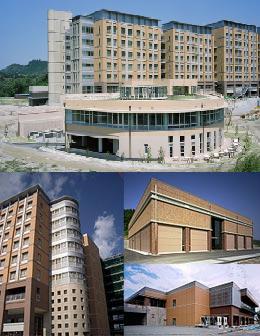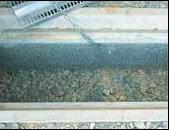♦Development
 West Zone 3 and 4 (Buildings for Engineering-Related Research and Education Wings II and III + Buildings for Experimental Research) and West
Zoon 2 (Buildings for Engineering-Related Research and Education) are already finished. During the first two years of relocation, one-fifth of the totality, or 100,000 m2 have been completed..
West Zone 3 and 4 (Buildings for Engineering-Related Research and Education Wings II and III + Buildings for Experimental Research) and West
Zoon 2 (Buildings for Engineering-Related Research and Education) are already finished. During the first two years of relocation, one-fifth of the totality, or 100,000 m2 have been completed..
The Sciences and Technology Library and facilities for supplying energy and water are almost completed and the information office (Big Orange) is in operation. Preparation of infrastructure is proceeding with construction of the cafeteria and dormitory. Nearby, urban renewal and construction of the Gakuen Dori Line by Fukuoka City proceeding at a rapid pace, and the new JR station (Kyudai-Gakkentoshi Station) is in place. Aiming to be an acceptable university, Students (including foreign students) and on-campus nonprofit organizations has already begun the interaction with the local community.
Furthermore, the Ito Campus is the stage for new developments in research. Initiatives aiming for a futuristic campus are underway. These include IC Campus Project that takes on new social issues such as protecting personal information and personal authentication in a networked society, adopting the IC cards using the PID (Personal ID) system based on technology developed at Kyushu University, the Hydrogen Campus Project that aims to be a research and development for the new energy source of hydrogen technology as well as a miniature demonstration, and user science that integrates user-based technologies and sensibilities.
Hydrogen Campus Project
Various joint projects between industry and academia are being planned and carried out at the Ito Campus. One of these is the Hydrogen Campus Project.
The goal of this project is to conduct multifaceted research on hydrogen, with Kyushu University and Fukuoka Prefecture as the key players, supported by the Ministry of Education, Culture, Sports, Science and Technology, the Ministry of Economy, Trade and Industry, and the world of industry. More than three hundred people, including students, technicians, assistants, assistant professors, and professors, are working together - conducting research and development on the use of hydrogen energy, training experts, and carrying out demonstration projects.
In addition, the Hydrogen Technology Research Center has been established. This is the only center in the world for research into integrated technologies for the safe use of hydrogen, and it is expected to become the project’s leading research base.
Campus-wide IC Card Project
 In order to improve services for the student body, as well as to enhance the level of efficiency of university operations by digitizing the whole campus, a plan to embed IC chips into student and staff identification cards is being developed. This will become the basis for conducting studies on the practical application of the advanced information system that was inaugurated with the opening of the new campus in the fall of 2005. This plan will advance upgrades to services and improve efficiency of business within the university, in accordance with the incorporation of national universities. As an area of comprehensive research and education activity, the IC card plan will also promote discussions from the vantage points of the humanities and social sciences with regard to the advanced technology of the new campus, and will generate proposals for the future direction of the university as an information society. This project will take the initiative on such new social issues as protection of personal information, and identity authentication in a networked society.
In order to improve services for the student body, as well as to enhance the level of efficiency of university operations by digitizing the whole campus, a plan to embed IC chips into student and staff identification cards is being developed. This will become the basis for conducting studies on the practical application of the advanced information system that was inaugurated with the opening of the new campus in the fall of 2005. This plan will advance upgrades to services and improve efficiency of business within the university, in accordance with the incorporation of national universities. As an area of comprehensive research and education activity, the IC card plan will also promote discussions from the vantage points of the humanities and social sciences with regard to the advanced technology of the new campus, and will generate proposals for the future direction of the university as an information society. This project will take the initiative on such new social issues as protection of personal information, and identity authentication in a networked society.
Through the use of IC cards on campus, services and efficiency can be improved in a wide-range of applications that target students and staff. These include school services, use of equipment and facilities including libraries and computers, prevention of crime and safety management, and automobile registration management. It is hoped that the introduction of campus-wide IC cards for all faculties will encourage the new campus to develop as a truly integrated university that can address the issue of what society should be in the 21st century.
Conservation and Management of Groundwater in the new campus
In the past, the area where the new campus is being constructed was a valuable watershed for the Mizusaki, Obaru, and Sugiyama Rivers, on hilly and primarily forested terrain. This area is also a valuable source of underground water that is used in the surrounding region.
 |
| picture 1 |
 |
| picture 2 |
Among their detailed contents, the measures include lessening reliance upon asphalt paving for roads (which obstructs the infiltration of rainwater), and a rule requiring water-permeable retaining catchments, drainpipes, and gutters to be constructed around buildings. Methods used to develop structures that allow for easier penetration of water include placing holes in drainpipes (picture 1) and spreading gravel or loose stones at the bottom of catchments (picture 2). Devices that permit water penetration into the ground over a period of time are also being developed, including spreading plastic blocks to make hollow cavities, and temporary storage of rainwater in surrounding areas under nearby parking lots and campus grounds where drainpipes pass under the soil.
While these measures will require additional costs over and beyond that of regular construction costs, Kyushu University believes that they are indispensable for cooperating with, living symbiotically with, and simultaneously developing with the surrounding area. These are basic good manners for anyone looking to develop this area.
- [Link]
- Photo archives
http://www.suisin.jimu.kyushu-u.ac.jp/en/showcase/photo/index.html - System LSI Research Center
http://www.slrc.kyushu-u.ac.jp/index.html - User Science Institute
http://www.usi.kyushu-u.ac.jp/
